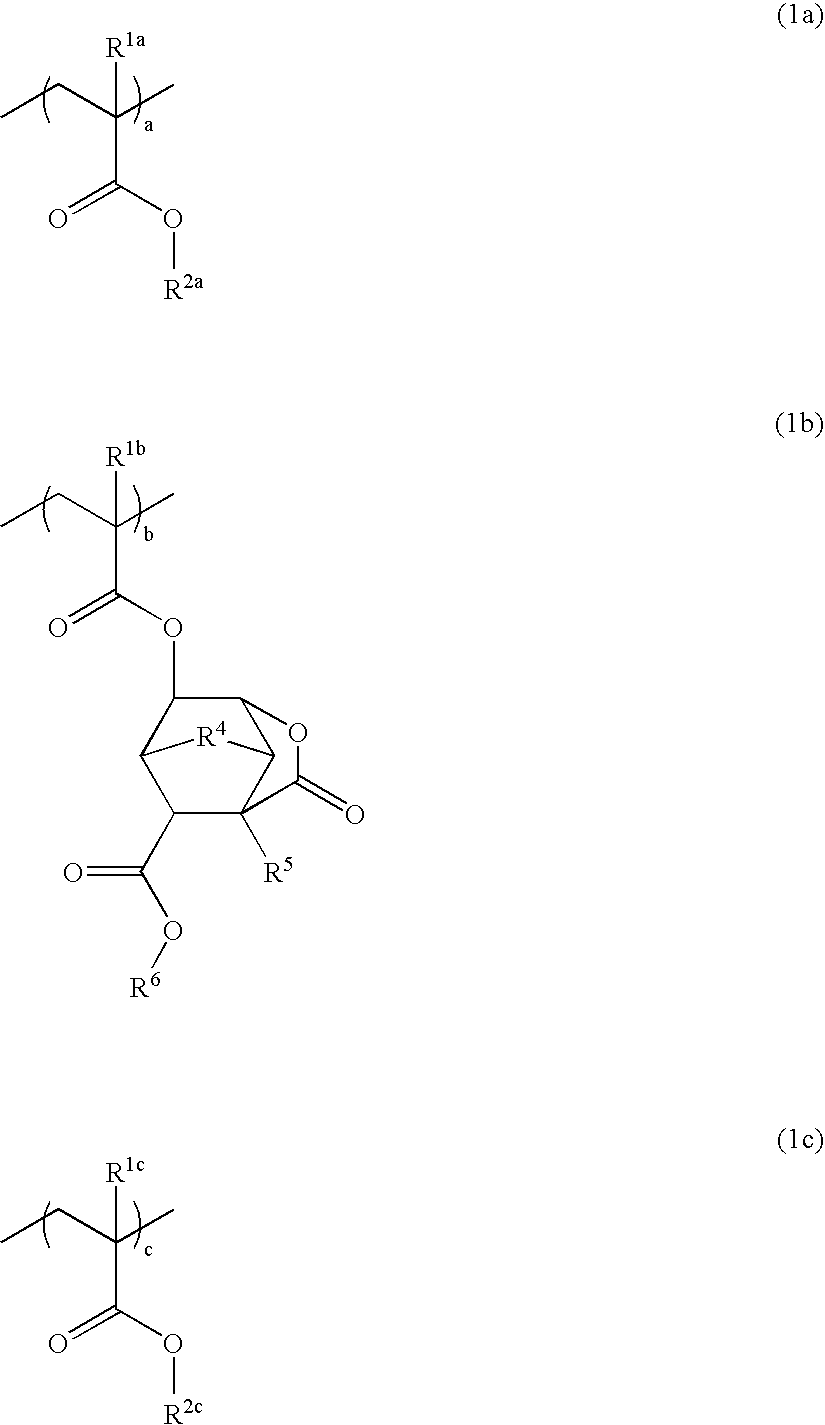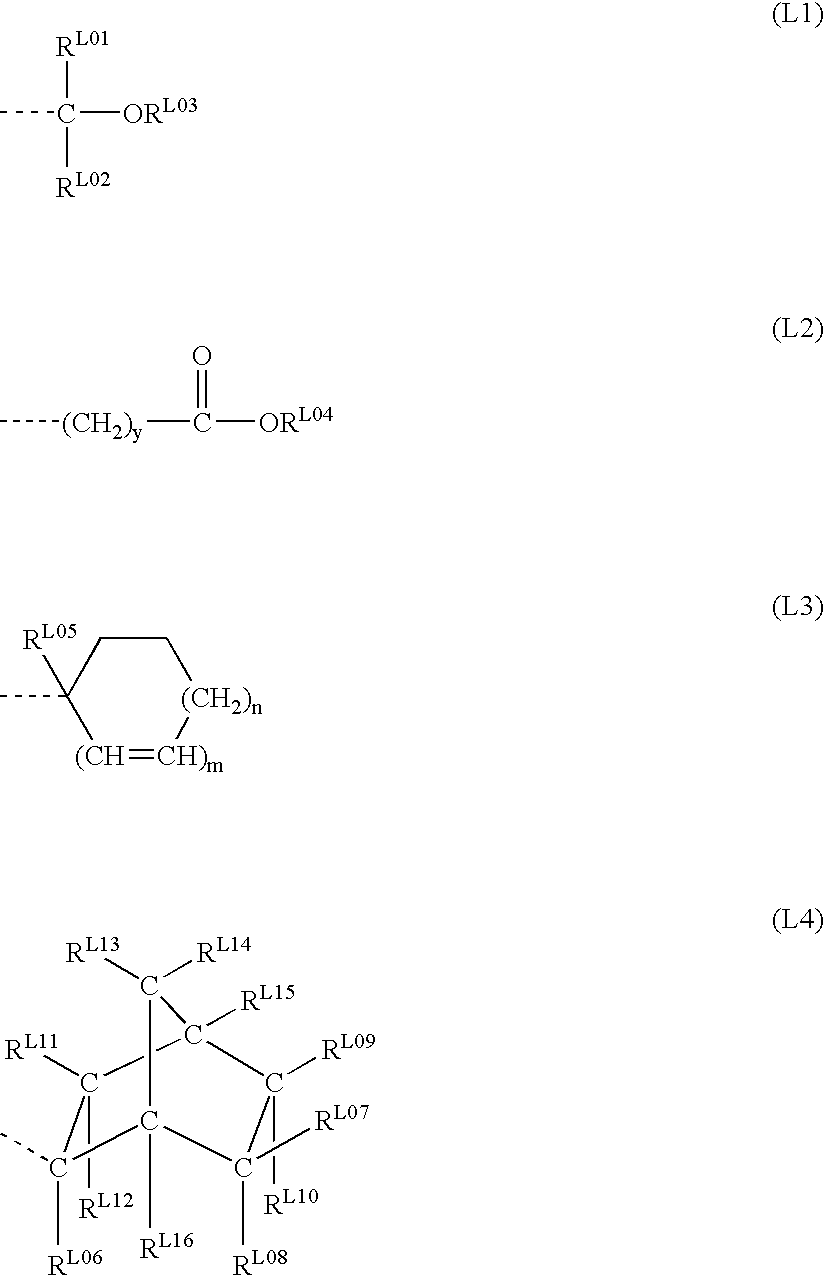Polymer, resist composition, and patterning process
a technology of resist composition and polymer, applied in the field of resist composition, can solve the problems of resist performance, fsub>2 /sub>lithography was postponed, and the use of resist film to generate defects, and achieve the effect of reducing the contact angl
- Summary
- Abstract
- Description
- Claims
- Application Information
AI Technical Summary
Benefits of technology
Problems solved by technology
Method used
Image
Examples
synthesis example 1
Monomer Synthesis Example 1
[0240]Synthesis of Monomer 1
[0241]
[1-1] Synthesis of 3-(2,2,2-trifluoroethoxycarbonyl)-5-norbornene-2-carboxylic acid
[0242]A flask was charged with 13.8 g of sodium hydride
[0243](purity 60%) and 80 ml of tetrahydrofuran, to which 33.0 g of 1,1,1-trifluoroethanol was added dropwise at 30° C. After the completion of dropwise addition, the contents were stirred at the temperature for one hour, then cooled down to 10° C. A mixture of 49.2 g of 5-norbornene-2,3-dicarboxylic anhydride and 150 ml of tetrahydrofuran was added dropwise. After the completion of dropwise addition, the contents were stirred at the temperature for one hour. 150 g of 10% hydrochloric acid was added to quench the reaction. This was followed by standard workup and recrystallization from n-hexane, obtaining 69.8 g of the target compound (yield 88%).
[0244]1H-NMR (600 MHz in CDCl3): δ=1.51 (1H, dd), 1.61 (1H, d), 2.76 (1H, dd), 3.18 (1H, s), 3.33 (1H, s), 3.45 (1H, t), 4.42-4.48 (1H, m), 4.5...
synthesis example 2
Monomer Synthesis Example 2
[0251]Synthesis of Monomer 3
[0252]
[2-1] Synthesis of 3-(1,1,1,3,3,3-hexafluoroisopropoxycarbonyl)-5-norbornene-2-carboxylic acid
[0253]A flask was charged with 223.5 g of 1,1,1,3,3,3-hexafluoroisopropyl alcohol and 500 ml of tetrahydrofuran, to which 500 ml of a solution (2.6 mole / L) of n-butyllithium in n-hexane was added dropwise at −10° C. After the completion of dropwise addition, the contents were stirred at room temperature for one hour, then cooled down to 10° C. A mixture of 198.5 g of 5-norbornene-2,3-dicarboxylic anhydride and 600 ml of tetrahydrofuran was added dropwise. After the completion of dropwise addition, the contents were stirred at 60° C. for 10 hours. 500 g of 10% hydrochloric acid was added to quench the reaction. This was followed by standard workup and recrystallization from n-hexane, obtaining 345.5 g of the target compound (yield 86%).
[0254]1H-NMR (600 MHz in CDCl3); δ=1.56 (2H, dt), 2.86 (1H, dd), 3.21 (1H, d-like), 3.37 (1H, d-l...
synthesis example 3
Monomer Synthesis Example 3
[0261]Synthesis of Monomer 4
[0262]Synthesis was carried out as [1-1] to [1-3] in Monomer Synthesis Example 1 aside from using 2,2,3,3,4,4,5,5-octafluoro-1-pentanol instead of 1,1,1-trifluoroethanol. There was obtained 7-(2,2,3,3,4,4,5,5-octafluoro-1-pentyloxycarbonyl)-2-oxohexahydro-3,5-methanol-2H-cyclopenta[b]furan-6-yl methacrylate (Monomer 4) in a three-step yield of 49%.
[0263]IR (thin film): ν=2983, 2933, 1791, 1758, 1724, 1639, 1456, 1405, 1340, 1321, 1299, 1253, 1172, 1114, 1076, 1043, 1018, 946 cm−1
[0264]1H-NMR (600 MHz in CDCl3): δ=1.12 (1H, d), 1.79 (1H, dd), 1.94 (3H, t), 2.00 (1H, dd), 2.91 (2H, d), 3.11 (1H, d-like), 3.28 (1H, dt-like), 4.54-4.62 (2H, m), 4.71-4.77 (2H, m), 5.63-5.64 (1H, m), 6.11 (1H, d-like) ppm
[0265]19F-NMR (565 MHz in CDCl3): δ=−137.9 to −137.7 (2F, m), −130.5 to −130.4 (2F, m), −126.0 (2F, t-like), −120.5 to −120.3 (2F, m) ppm
[0266]
PUM
| Property | Measurement | Unit |
|---|---|---|
| wavelength | aaaaa | aaaaa |
| size | aaaaa | aaaaa |
| refractive index | aaaaa | aaaaa |
Abstract
Description
Claims
Application Information
 Login to View More
Login to View More - R&D
- Intellectual Property
- Life Sciences
- Materials
- Tech Scout
- Unparalleled Data Quality
- Higher Quality Content
- 60% Fewer Hallucinations
Browse by: Latest US Patents, China's latest patents, Technical Efficacy Thesaurus, Application Domain, Technology Topic, Popular Technical Reports.
© 2025 PatSnap. All rights reserved.Legal|Privacy policy|Modern Slavery Act Transparency Statement|Sitemap|About US| Contact US: help@patsnap.com



